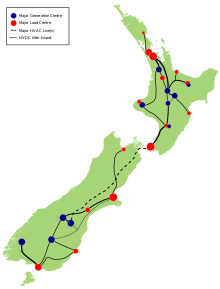
The National Grid is the nationwide system of electric power transmission in New Zealand. The grid is owned, operated and maintained by Transpower New Zealand, a state-owned enterprise, although some lines are owned by local distribution companies and leased to Transpower. In total, the national grid contains 11,803 kilometres (7,334 mi) of high-voltage lines and 178 substations.
Much of New Zealand’s electricity generation is hydroelectric, the majority of which is from power stations on lakes and rivers in the lower half of the South Island, while most of the electricity demand is in the North Island, in particular, the Auckland region. Consequently, large amounts of electricity need to be transmitted long distances from power stations to electricity users, including transmission across Cook Strait through the HVDC Inter-Island link.[1]
Investments in new transmission are regulated by the Electricity Commission and the Commerce Commission. In a news release in January 2012, the Commerce Commission reported that Transpower was planning to invest $5 billion over the next 10 years in upgrades of critical infrastructure.[2]
- ^ "A Guide to Transpower 2009" (PDF). Archived from the original (PDF) on 2011-06-11. Retrieved 2009-04-16.
- ^ "Commerce Commission finalises input methodology for approving Transpower's national grid spending". Commerce Commission. 31 January 2012. Archived from the original on 10 February 2013. Retrieved 24 April 2012.